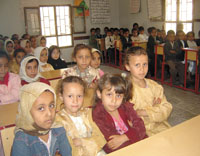
Hajjah governorate gets an elementary education overhaul [Archives:2008/1154/Reportage]
May 12 2008
 |
Although Yemen's formal education system began after the 1962 Revolution, many governorates like Hajjah still suffer from lack of trained teachers, poor schools and a drop in the number of female students.
However, two programs are attempting to remedy this situation. The German Agency for Technical Cooperation, called GTZ, began training Hajjah governorate elementary teachers in 2004 following similarly successful programs in other governorates. Called the Basic Education Improvement Program, or BEIP, the teacher-training project will continue until October of this year.
Likewise, in 2003, the Yemeni government outlined a national strategy to improve the quality of elementary teaching and increase female education. In this regard, it too has been implementing a project in Hajjah.
Both the German and Yemeni governments are cooperating and sharing resources in an effort to make their programs successful.
Most schools in Hajjah's 31 districts are hardly fit to be called that, with many resembling nests more than anything else, being made of stacked boxes, arranged underneath trees or sometimes meeting in small rented homes, remarked Jamal Al-Ghashimi, deputy director of the governorate's Education Office.
Those districts struggling against poor education conditions and “nest schools” include Al-Jumaima'a, Khara, Qatha'a Al-Sharafayn, Tihama and Qushar, noted Ahmed Al-Mu'alimi, who heads the governorate's Education Office.
It's a step in the right direction that UNICEF, Yemen's Social Fund for Development, local councils and donors like the German Bank for Reconstruction and Development are attempting to build and improve schools in these areas. “However, problems still exist and without these donors, Yemen can't continue to improve its education sector,” Al-Mu'alimi said.
According to Al-Ghashimi, the governorate has approximately 1,360 schools in general, with 970 elementary schools, of which 760 are coeducational, teaching boys and girls together.
“Although many schools have been built, [we] find that many still are needed,” says Lise Voss-Lengnile, training advisor for GTZ's Basic Education Improvement Program. Although these new school buildings in poor areas undoubtedly are a great help, quality of education and lack of female student participation remain huge problems.
Female enrollment starts high, but quickly drops off
Approximately 60 percent of Hajjah area children don't attend school, most of whom are girls, points out Ali Mohammed Noman, who works in the governorate in tandem with GTZ to help develop elementary education.
Because many Hajjah schools are coeducational, this often prevents parents from sending their girls to school. “According to Yemeni social standards, parents don't allow their girls to study with boys when they're nearly adults,” explains Mohammed Al-Shadhowi, head of the education sector in Hajjah's Mabyan district.
However, he adds, “Because of minimal funding and lack of support from the Ministry of Education, we can't provide more classes for girls.”
The number of girls enrolled at the beginning of every school year starts out well, but then quickly decreases.
Another problem contributing to the high rate of female student dropouts is lack of suitable bathrooms, as many schools have none, which makes attending extremely difficult for girls.
Additionally, because the distance between the school and their homes usually is quite far and roads often are unsafe to walk alone, according to Al-Mu'alimi, female students stay home instead.
“If the government would provide special schools for girls, many would come, but thus far, we can only counsel and make parents aware of the importance of educating their daughters,” Al-Ghashimi said.
“The Education Ministry could give us a bigger budget to improve the education sector, to equip our schools with bathrooms, laboratories, etc. We don't even receive books at the right time and many times, they ignore us,” Al-Shadhowi complained.
Unqualified teachers can't properly educate students
Another major problem in Hajjah is unqualified teachers sent by the Ministry of Education. “Honestly, the teacher graduates the Education Ministry sends us aren't qualified at all, which is why we're trying to train them,” Al-Ghashimi remarked.
“At first, we took into account the number of teachers, whether they were qualified or not, but now we only care about the quality of teachers in order to benefit the students better,” Al-Mu'alimi said.
Since 2003, the Education Ministry's national strategy for teacher training and improving female education has trained more than 8,000 teachers in Hajjah's 31 districts, according to Al-Mu'alimi. In seeking to increase female access to education, the strategy targeted 20 districts in the governorate.
With GTZ's help, the national strategy is due to be completed in 2015 in accordance with the United Nations' Millennium Development Goals, according to Al-Mu'alimi.
“The most important thing is teachers' skills,” Noman pointed out, noting that many teachers had problems, such as difficulty preparing subjects before class, inability to solve students' problems and control the class, in addition to how to develop and improve themselves.
“The first training was 12 days each in science and Arabic,” said Hamoud Al-Kuhlani, head of Al-Jadid School, adding, “They also taught the teachers how to deal with students.”
“We as a program are watching the teachers to see whether they are doing well or not,” Noman said, noting, “The teachers meet together in the governorate every three months to discuss and share their experiences.” The meetings are staggered so that all 8,000 meet every three months.
“The project will finish this October and then we'll start another program,” Lengnile said, adding that it has cost approximately $1 million.
“We [GTZ] have trained 1,200 elementary teachers in 450 schools eight districts, choosing two mountainous areas, two coastal areas and four central areas,” Noman explained, “We've also involved the communities themselves in participating with the school and encouraged parents to allow their daughters to attend school in order to receive an education.”
As Lengnile points out, “Following the national and GTZ training programs, most teachers have begun paying more attention to their students and the teaching style also has changed for the better.”
“The training was very successful for all of us. Also, the parents' council that was established is participating with teachers and schools to improve students' future,” Ali Al-Ja'afali, social worker at Al-Jadid School, said.
“The parents' council receives advice [from GTZ] to promote sending their daughters to school and allowing them to complete their education,” Lengnile added.
Background of the education program
“At first, we worked in two governorates – Ibb and Abyan – since 1996, focusing on health and environmental education,” Lengnile explained, “Then, from 2002, it became the Basic Education Improvement Project.”
The project is an agreement between Germany and Yemen, and was at the request of the Yemeni side, according to Lengnile.
——
[archive-e:1154-v:18-y:2008-d:2008-05-12-p:report]


